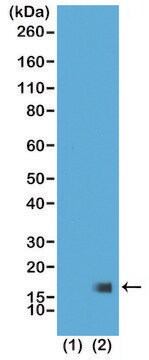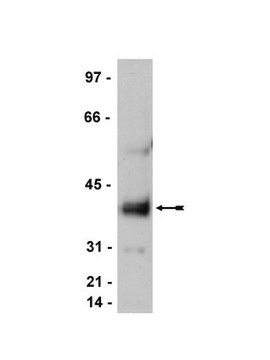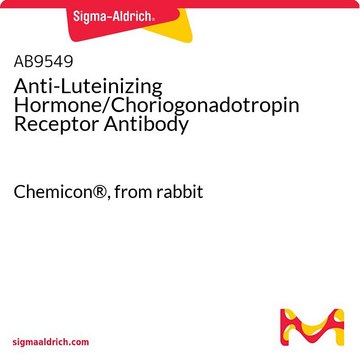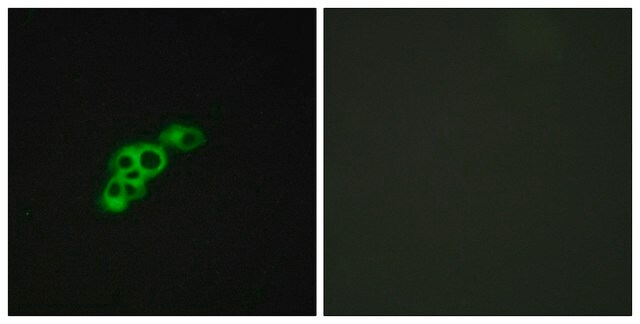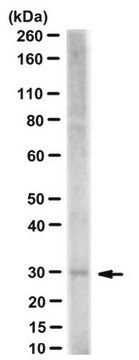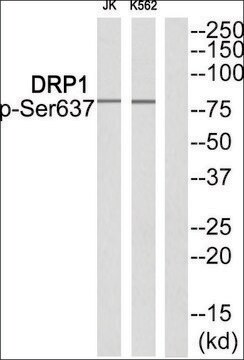MABE1079
Anti-TAF10/TAFII30 Antibody, clone 6TA-2B11
ascites fluid, clone 6TA-2B11, from mouse
Synonym(s):
Transcription initiation factor TFIID subunit 10, STAF28, TAF(II)30, TAFII-30, TAFII30, Transcription initiation factor TFIID 30 kDa subunit
About This Item
IP
WB
immunoprecipitation (IP): suitable
western blot: suitable
Recommended Products
biological source
mouse
Quality Level
antibody form
ascites fluid
antibody product type
primary antibodies
clone
6TA-2B11, monoclonal
species reactivity
mouse, human
technique(s)
immunocytochemistry: suitable
immunoprecipitation (IP): suitable
western blot: suitable
isotype
IgG1κ
NCBI accession no.
UniProt accession no.
shipped in
dry ice
target post-translational modification
unmodified
Gene Information
human ... TAF10(6881)
General description
Specificity
Immunogen
Application
Western Blotting Analysis: A 1:1,000 dilution of this antibody detected TAF10/TAFII30 in TAFIID complex isolated from HeLa nuclear extract (Courtesy of Dr. Mustapha OULAD-ABDELGHANI, IGBMC, France).
Immunoprecipitation Analysis: A representative lot immunoprecipitated TAF10 together with associated GATA1 from murine erythroleukemia (MEL) cell nuclear extracts (Papadopoulos, P., et al. (2015). Mol. Cell. Biol. 35(12):2103-2118).
Western Blotting Analysis: A representative lot detected TAF10 in E12.5 mouse fetal liver nuclear extracts and murine erythroleukemia (MEL) cell nuclear extracts, as well as in GATA1 immunoprecipitate from MEL cell and fetal liver nuclear extracts (Papadopoulos, P., et al. (2015). Mol. Cell. Biol. 35(12):2103-2118).
Immunocytochemistry Analysis: A representative lot detected TAF10 immunoreactivity in trophoblasts from 3-day cultured wild-type, but not Taf10-/-mouse embryonic blastocysts isolated at 3.5 dpc (days post-coitum) by immunofluorescent staining of 1% paraformaldehyde-fixed, 0.1% Tween 20-permeabilized blastocysts (Mohan, W.S. Jr, et al. (2003). Mol .Cell. Biol. 23(12):4307-4318).
Epigenetics & Nuclear Function
Transcription Factors
Quality
Western Blotting Analysis: A 1:2,000 dilution of this antibody detected TAF10/TAFII30 in 10 µg of A431 cell lysate.
Target description
Physical form
Storage and Stability
Handling Recommendations: Upon receipt and prior to removing the cap, centrifuge the vial and gently mix the solution. Aliquot into microcentrifuge tubes and store at -20°C. Avoid repeated freeze/thaw cycles, which may damage IgG and affect product performance.
Other Notes
Disclaimer
Not finding the right product?
Try our Product Selector Tool.
Storage Class Code
12 - Non Combustible Liquids
WGK
WGK 1
Flash Point(F)
Not applicable
Flash Point(C)
Not applicable
Certificates of Analysis (COA)
Search for Certificates of Analysis (COA) by entering the products Lot/Batch Number. Lot and Batch Numbers can be found on a product’s label following the words ‘Lot’ or ‘Batch’.
Already Own This Product?
Find documentation for the products that you have recently purchased in the Document Library.
Our team of scientists has experience in all areas of research including Life Science, Material Science, Chemical Synthesis, Chromatography, Analytical and many others.
Contact Technical Service

